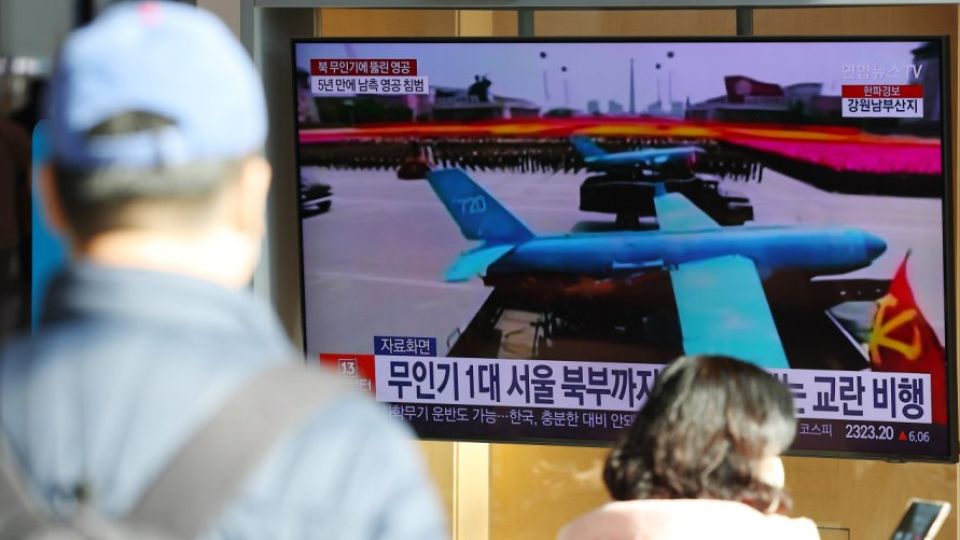January 6, 2023
SEOUL – The South Korean military on Thursday belatedly confirmed an uncrewed North Korean aerial vehicle flew over no-fly zones designated around the presidential office and residence in central Seoul, walking back on earlier remarks that it did not do so.
The Joint Chiefs of Staff statement was made during a closed-door briefing on the interim outcomes of its ongoing investigation on the intrusion of five uncrewed air vehicles, or UAVs, into South Korean airspace on Dec. 26 last year. They flew over the densely populated city of Seoul and residential areas along the western inter-Korean border for hours, but the South Korean military failed to bring down any of them.
“Our detailed analysis of records suggests that flight trails of what we’ve presumed to be the enemy’s one small UAV flew over a part of the northern end of a no-fly zone,” a senior military official in charge of the investigation told local media outlets on condition of anonymity.
The latest announcement was a reversal of the military’s previous statements that a North Korean UAV never entered any no-fly zones.
For the purpose of presidential security, South Korea has set two no-fly zones, better known as P-73, which cover a radius of 3.7 kilometers centered on the new presidential office and residence in Yongsan-gu, Seoul.
Although the JCS declined to confirm which no-fly zone was breached, a map previously provided by the military showed that the North Korean UAV flew over Jongno-gu in downtown Seoul. The no-fly zone over the presidential residence — which covers Jongno-gu — could have been breached.
The JCS claimed it posed no safety issue for President Yoon Suk Yeol’s office in Yongsan, and did not share specific flight trails of the North Korean UAV for “security reasons.” Yoon was briefed on the issue on Wednesday.
Earlier, the JCS had rejected media reports that said one North Korean UAV entered the P-73 no-fly zones.
“It’s completely untrue that one uncrewed North Korean aerial vehicle breached a no-fly zone,” JCS spokesperson Col. Lee Sung-jun said during a televised briefing on Dec. 29. “I expressed my strong regret over the unfounded story that is not true.”
At that time, Lee underscored that the South Korean military tracked “most of the flight trails” of the UAVs in Seoul with a larger number of detection and tracking systems, ruling out the possibility of the military’s misjudgment.
Speaking at Thursday’s closed-door briefing, another unnamed high-ranking military official claimed that the earlier statements were based on reports from intelligence and operations officers at that time, adding that officers had assessed that detected flight trails were not related to the North Korean UAV.
But later, intelligence and operations officers figured that there could be a “high chance” of one North Korean UAV passing through the northern edge of the no-fly zone. The JCS has been investigating why officers failed to identify detected flight trails as the North Korean UAV.
“I have a credo that the military must not cover up in light of public confidence in the military,” the high-ranking military official said, underscoring the military seeks to transparently share information with the public. “I’ve made a very important decision to explain it although we see high chances (of infiltration).”
JCS spokesperson Col. Lee said later in the day that the South Korean military “has expressed its regret for the confusion caused by the differences” between its initial assessment and the interim outcomes of the investigation.
The JCS also dismissed the possibility of the North Korean UAV — which was presumed to fly over Seoul for around one hour at a low altitude of 3 km — to have filmed the presidential office and key facilities. It did not provide any evidence for its claim.
But South Korea’s National Intelligence Service shared an assessment which appeared to contradict the military’s statement during a closed-door briefing to the parliamentary intelligence committee on Thursday afternoon.
The South Korean spy agency said it “cannot rule out the possibility” of the North Korean UAV filming the presidential office in Yongsan when asked by lawmakers, Rep. Yoo Sang-beom of the ruling People Power Party told reporters following the briefing.
Meanwhile, the JCS conducted joint air defense drills — which simulate the infiltration of North Korean small UAVs — by mobilizing around 50 aircraft, including KA-1 light attack aircraft, Cobra attack helicopters, and MD500 helicopters, in the eastern and western parts of South Korea on Thursday afternoon.
As part of the drills, live-fire exercises were staged to practice tracking and bringing down enemy aircraft in the Daecheon shooting range in South Chungcheong Province.
The JCS said the air defense drills aim to master procedures for counter-drone operations in real-life scenarios, which have been updated in the aftermath of the counter-drill exercise on Dec. 29.


